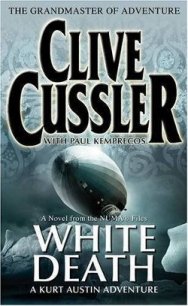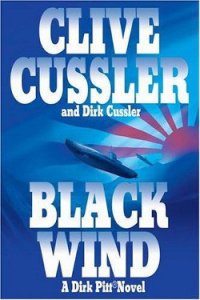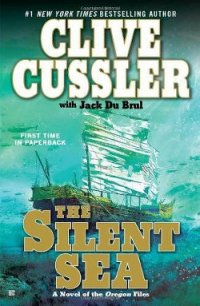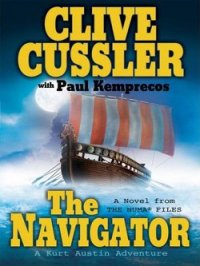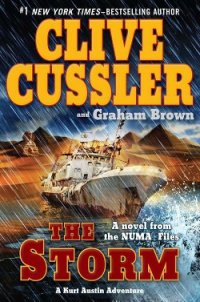Lost City - Cussler Clive (читать книги полные TXT) 📗
"I don't understand."
"You will, my dear. You will."
The French Alps
THE AEROSPATIALE ALOUETTE light utility helicopter threading its way through the deep alpine valleys appeared as insignificant as a gnat against the backdrop of towering peaks. As the helicopter approached a mountain whose summit was crowned with three uneven knobs, Hank Thurston, seated in the front passenger's seat, tapped the shoulder of the man sitting beside him and pointed through the canopy.
"That's "Le Dormeur," " Thurston said, raising his voice to be heard over the thrashing rotor blades. " "The Sleeping Man." The profile supposedly resembles the face of a sleeper lying on his back."
Thurston was a full professor of glaciology at Iowa State University. Although the scientist was in his forties, his face exuded a boyish enthusiasm. Back in Iowa, Thurston kept his face clean-shaven and his hair neatly trimmed, but after a few days in the field he began to look like a bush pilot. It was a look he cultivated by wearing aviator sunglasses, letting his dark brown hair grow long so gray strands would show and by shaving infrequently, so that his chin was usually covered with stubble.
"Poetic license," said the passenger, Derek Rawlins. "I can see the brow and the nose and chin. It reminds me of the Old Man of the Mountain in New Hampshire before it fell apart, except that the stone profile here is horizontal rather than vertical."
Rawlins was a writer for Outside magazine. He was in his late twenties, and with his air of earnest optimism and neatly trimmed sandy-blond hair and beard, he looked more like a college professor than Thurston did.
The crystal clarity of the air created an illusion of nearness, making the mountain seem as if it was only an arm's length away. After a couple of passes around the crags, the helicopter broke out of its lazy circle, scudded over a razorback ridge and dropped down into a natural bowl several miles across. The floor of the mountain basin was covered by an almost perfectly round lake. Although it was summer, ice cakes as big as Volkswagens floated on the ipirrorlike surface.
"Lac du Dormeur," the professor said. "Carved out by a retreating glacier during the Ice Age and now fed by glacial waters."
"That's the biggest martini on the rocks I've ever seen," Rawlins said.
Thurston laughed. "It's as clear as gin, but you won't find any olive at the bottom. That big square structure built into the mountain off to the side of the glacier is the power plant. The nearest town is on the other side of the mountain range."
The aircraft passed over a wide, sturdy-looking vessel anchored near the shore of the lake. Cranes and booms protruded from the boat's deck.
"What's going on down there?" Rawlins said.
"Some sort of archaeological project," Thurston said. "The boat must have come up the river that drains the lake."
"I'll check it out later," Rawlins said. "Maybe I can pry a raise out
of my editor if I come back with two stories for the price of one." He glanced ahead at a wide ice floe that filled the gap between two mountains. "Wow! That must be our glacier."
"Yup. Im Langue du Dormeur. "The Sleeper's Tongue." " The helicopter made a pass over the river of ice that flowed down a wide valley to the lake. Rugged, snow-dusted foothills of black rock hemmed the glacier in on both sides, shaping it into a rounded point. The edges of the ice field were ragged where the flow encountered crevasses and ravines. The ice had a bluish tinge and was cracked along its surface like the parched tongue of a lost prospector.
Rawlins leaned forward for a better look. "The Sleeper should see a doctor. He's got a bad case of trench mouth."
"As you said, poetic license," Thurston said. "Hold on. We're about to land."
The helicopter darted over the leading edge of the glacier and the pilot put the aircraft into a slow banking turn. Moments later, the chopper's runners touched down on a brown grassy strip a couple of hundred feet from the lake.
Thurston helped the pilot unload a number of cartons from the helicopter and suggested that Rawlins stretch his legs. The reporter walked to the water's edge. The lake was unearthly in its stillness. No ripple of air disturbed the surface, which looked hard enough to walk across. He threw a stone to reassure himself that the lake wasn't frozen solid.
Rawlins's gaze shifted from the widening ripples to the boat anchored about a quarter mile from shore. He recognized the distinctive turquoise blue-green color of the hull immediately. He had encountered vessels of similar color while on writing assignments. Even without the letters numa painted in bold black letters on the hull, he would have known the boat belonged to the National Underwater and Marine Agency. He wondered what a NUMA vessel was doing in this remote place far from the nearest ocean.
There was definitely an unexpected story here, but it would have to wait. Thurston was calling him. A battered Citroen 2C was hurtling toward the parked helicopter in a cloud of dust. The pint-sized auto skidded to a stop next to the chopper and a man who resembled a mountain troll emerged from the driver's side like a creature hatched from a deformed egg. He was short and dark-complexioned, with a black beard and long hair.
The man pumped Thurston's hand. "Wonderful to have you back, Monsieur le profess eur And you must be the journalist, Monsieur Rawlins. I am Bernard LeBlanc. Welcome."
"Thanks, Dr. LeBlanc," Rawlins said. "I've been looking forward to my visit. I can't wait to see the amazing work you're doing here."
"Come along then," LeBlanc said, snatching up the reporter's duffel bag. "Fifi awaits." "Fifi?" Rawlins looked around as if he expected to see a dancer from the Follies Bergere.
Thurston irreverently jerked his thumb at the Citroen. "Fifi is the name of Bernie's car."
"And why shouldn't I give my car a woman's name?" LeBlanc said with a mock expression of pique. "She is faithful and hardworking. And beautiful in her own way."
"That's good enough for me," Rawlins said. He followed LeBlanc to the Citroen and got in the backseat. The boxes of supplies were secured to the roof rack. The other men got in the front and LeBlanc drove Fifi toward the base of the mountain that flanked the right side of the glacier. As the car began its ascent up a gravel road, the helicopter lifted off, gained altitude over the lake and disappeared behind the high ridge.
"You're familiar with the work being done at our subglacial observatory, Monsieur Rawlins?" LeBlanc said over his shoulder.
"Call me Deke. I've read the material. I know that your setup is similar to the Svartisen glacier in Norway."
"Correct," Thurston chimed in. "The Svartisen lab is seven hundred feet under the ice. We're closer to eight hundred. In both places, the melting glacier water is channeled into a turbine to produce hydroelectric power. When the engineers drilled the water conduits, they bored an extra tunnel under the glacier to house our observatory."
The car had entered a forest of stunted pine. LeBlanc drove along the narrow track with seemingly reckless abandon. The wheels were only inches from sheer drop-offs. As the incline became steeper, the Citroen's tiny workhorse of an engine began to wheeze.
"Sounds like Fifi is showing her age," Thurston said.
"It is her heart that is important," LeBlanc replied. Nevertheless, they were crawling at a tortoise pace when the road came to an end. They got out of the car and LeBlanc handed them each a shoulder harness, donning one himself. A box of supplies was strapped onto each harness.
